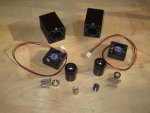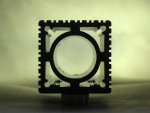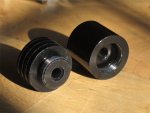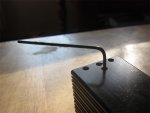- Joined
- Oct 26, 2007
- Messages
- 5,438
- Points
- 83
I had been on the lookout for cheap labby heatsinks for projector lasers. Such heatsinks used to be part of labby lasers that DealExtreme sold, but they stopped selling such lasers to US customers. Recently, I noticed a number of nice labby-style heatsinks appearing in cheap projector units you can buy from DinoDirect or other stores and looked on eBay for some to buy. As luck would have it, an eBay Seller did have the heatsinks.

I bought two of the variety the 445nm lasers on the L-86 projector used (left laser). They cost about $28 for one with a 445nm-coated glass lens, and $26 for one with a red-coated glass lens. Both lenses are fully threaded in a metal case; no spring was included. There is also a lens for 405nm on the site, but I don't know what the difference would be compared to the one for 445nm.

Heatsink Parts
A hollow aluminum extrusion.

Unlike the other two heatsinks in that projector (this style), the one for the 445nm laser has a hollow extrusion. This allows air to pass through the heatsink and out the other end, rather than around it as in the other style. I'm not sure how well this actually reduces the heat, but it seems it would have better airflow.
An aluminum slug for holding the diode and lens.

Unlike the the 18mm modules from O-like, the rear casing has only half the length. However, the back casing is only minimally hollow, to give it more thermal mass. The slug has a finned front end, which probably doesn't help the heat transfer much unless you choose to stick it out the front (which I doubt you will). It's probably finned as it is a premade part sourced elsewhere.

The slug is held in place by a set-screw. Check the bags to make sure you don't lose it. I nearly lost one because it fell out of the heatsink and was loose in the bag. In addition to the set-screw, I would also use some glue and/or thermal grease to ensure good heat transfer and to prevent the slug from moving.
A fan on the rear.

The addition of a fan for active cooling is a nice addition. It is loud, but does its job. Note the hole above the fan for feeding wires out.
Overall, I think this will be a nice heatsink for projector lasers, as it is the correct height for most "standard" projector optics, well-built, has presumably good cooling, and is relatively inexpensive.
I bought two of the variety the 445nm lasers on the L-86 projector used (left laser). They cost about $28 for one with a 445nm-coated glass lens, and $26 for one with a red-coated glass lens. Both lenses are fully threaded in a metal case; no spring was included. There is also a lens for 405nm on the site, but I don't know what the difference would be compared to the one for 445nm.
Heatsink Parts
A hollow aluminum extrusion.
Unlike the other two heatsinks in that projector (this style), the one for the 445nm laser has a hollow extrusion. This allows air to pass through the heatsink and out the other end, rather than around it as in the other style. I'm not sure how well this actually reduces the heat, but it seems it would have better airflow.
An aluminum slug for holding the diode and lens.
Unlike the the 18mm modules from O-like, the rear casing has only half the length. However, the back casing is only minimally hollow, to give it more thermal mass. The slug has a finned front end, which probably doesn't help the heat transfer much unless you choose to stick it out the front (which I doubt you will). It's probably finned as it is a premade part sourced elsewhere.
The slug is held in place by a set-screw. Check the bags to make sure you don't lose it. I nearly lost one because it fell out of the heatsink and was loose in the bag. In addition to the set-screw, I would also use some glue and/or thermal grease to ensure good heat transfer and to prevent the slug from moving.
A fan on the rear.
The addition of a fan for active cooling is a nice addition. It is loud, but does its job. Note the hole above the fan for feeding wires out.
Overall, I think this will be a nice heatsink for projector lasers, as it is the correct height for most "standard" projector optics, well-built, has presumably good cooling, and is relatively inexpensive.









